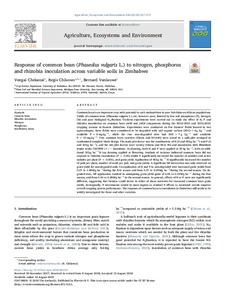| dc.contributor.author | Chekanai, V. |
| dc.contributor.author | Chikowo, Regis |
| dc.contributor.author | Vanlauwe, Bernard |
| dc.date.accessioned | 2019-12-04T11:26:25Z |
| dc.date.available | 2019-12-04T11:26:25Z |
| dc.date.issued | 2018-11 |
| dc.identifier.citation | Chekanai, V., Chikowo, R. & Vanlauwe, B. (2018). Response of common bean (Phaseolus vulgaris L.) to nitrogen, phosphorus and rhizobia inoculation across variable soils in Zimbabwe. Agriculture, Ecosystems & Environment, 266, 167-173. |
| dc.identifier.issn | 0167-8809 |
| dc.identifier.uri | https://hdl.handle.net/20.500.12478/4595 |
| dc.description | Open Access Article; Published online: 18 Aug 2018 |
| dc.description.abstract | Common bean is an important crop with potential to curb malnutrition in poor Sub-Saharan African populations. Yields of common bean (Phaseolus vulgaris L.) are, however poor, limited by low soil phosphorus (P), nitrogen (N) and poor biological N2-fixation. On-farm experiments were carried out to study the effect of N, P and rhizobia inoculation on common bean yield and yield components during the 2014/2015 and 2015/2016 cropping seasons in Eastern Zimbabwe. Experiments were conducted on five farmers’ fields located in two agroecologies; three fields were considered to be degraded with soil organic carbon (SOC) < 4 g kg−1 and available P < 6 mg kg−1, while the two non–degraded sites had SOC > 7 g kg−1 and available P > 15 mg kg−1. Two common bean varieties (Gloria and NUA45) were tested in a split-plot arranged in randomized complete block design. The main plot factor was the combination of N (0 and 40 kg ha−1) and P (0 and 20 kg ha−1), and the sub-plot factors were variety (Gloria and NUA 45) and inoculation with Rhizobium tropici strain CIAT899 (+/− inoculum). At planting, both N and P were applied at 20 kg ha−1, with an additional 20 kg ha−1 N top dressing applied at flowering. Analysis of variance indicated common bean did not respond to rhizobia inoculation (P > 0.05) whilst P significantly increased the number of nodules and active nodules per plant (P < 0.001), and grain yield. Application of 40 kg ha−1 N significantly increased the number of pods per plant, number of seeds per pod, and grain yields. A significant NP interaction was only observed on grain yield for non-degraded soils. Co-application of N and P in non-degraded sites increased grain yields from 0.27 to 1.48 Mg ha−1during the first season and from 0.37 to 2.09 Mg ha−1during the second season. On degraded sites, NP application resulted in uninspiring grain yield gains of 0.09 to 0.19 Mg ha−1 during the first season, and from 0.16 to 0.28 Mg ha−1 in the second season. In general, effects of N or P were not significantly different, suggesting that farmers could invest in either of these nutrients for increased common bean grain yields. Strategically, P investments would be more logical as residual P effects to rotational cereals improve overall cropping system performance. The response of common bean to inoculation in Zimbabwe still needs to be widely investigated for these and other varieties. |
| dc.description.sponsorship | Bill & Melinda Gates Foundation |
| dc.format.extent | 167-173 |
| dc.language.iso | en |
| dc.subject | Common Bean |
| dc.subject | Nitrogen |
| dc.subject | Phosphorus |
| dc.subject | Cropping Systems |
| dc.title | Response of common bean (Phaseolus vulgaris L.) to nitrogen, phosphorus and rhizobia inoculation across variable soils in Zimbabwe |
| dc.type | Journal Article |
| dc.description.version | Peer Review |
| cg.contributor.crp | Maize |
| cg.contributor.crp | Roots, Tubers and Bananas |
| cg.contributor.affiliation | University of Zimbabwe |
| cg.contributor.affiliation | International Institute of Tropical Agriculture |
| cg.coverage.region | Africa |
| cg.coverage.region | East Africa |
| cg.coverage.country | Zimbabwe |
| cg.creator.identifier | bernard vanlauwe: 0000-0001-6016-6027 |
| cg.researchtheme | NATURAL RESOURCE MANAGEMENT |
| cg.isijournal | ISI Journal |
| cg.authorship.types | CGIAR and developing country institute |
| cg.iitasubject | Farming Systems |
| cg.iitasubject | Natural Resource Management |
| cg.journal | Agriculture, Ecosystems & Environment |
| cg.howpublished | Formally Published |
| cg.accessibilitystatus | Open Access |
| local.dspaceid | 100846 |
| cg.targetaudience | Scientists |
| cg.identifier.doi | https://dx.doi.org/10.1016/j.agee.2018.08.010 |

